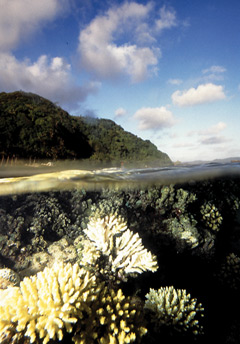|
|
Office of National Marine Sanctuaries
The Office of National Marine Sanctuaries (ONMS) manages 13 sanctuaries and one marine national monument encompassing more than 150,000 square miles of U.S. ocean and Great Lakes waters. Important habitats like breeding and feeding grounds of whales, sea lions, sharks, and sea turtles; coral reefs; kelp forests; and historic shipwrecks are represented within the National Marine Sanctuary System. Further west, the Hawaiian Islands Humpback Whale sanctuary encompasses breeding grounds used by the endangered species for this majestic whale. In 2006, the Papahanaumokuakea Marine National Monument was created. The monument, which is managed by NOAA and the Department of the Interior's U.S. Fish and Wildlife Service in close coordination with the State of Hawaii, contains over 70 percent of all U.S. coral reefs. The area is also home to several federally protected species including the Hawaiian monk seal and the green sea turtle. Fagatele Bay National Marine Sanctuary, located in American Samoa, encompasses fringing coral reefs nestled within an eroded volcanic crater. In the Gulf of Mexico, the Flower Garden Banks sanctuary manages and protects pristine, deep-water corals. In the Atlantic, remains of the Civil War ironclad, the USS Monitor, are protected within the Monitor National Marine Sanctuary. Gray’s Reef, Stellwagen Bank, and the Florida Keys national marine sanctuaries contain coral reefs, important fishing grounds, and habitat for endangered right whales. The most recently designated national marine sanctuary, Thunder Bay in Lake Huron, manages and protects a wealth of historic shipwrecks—an area dubbed “Shipwreck Alley.”
Research, Monitoring, and Education Each sanctuary office maintains on-site field staff that conduct research and monitoring, resource protection, and educational activities. Research and monitoring programs evaluate the status and health of marine species, habitats, and ecosystems in support of resource protection efforts. Resource protection activities use a variety of means, including regulations and permits, emergency response activities, enforcement, and education, to reduce or prevent detrimental human impacts. Education and outreach activities are used to enhance public understanding and stewardship of the sanctuaries and range from public events and interactive teacher workshops to extensive written materials. The ONMS also manages martime heritage resources within the sanctuary system and promotes maritime heritage appreciation throughout the entire nation. (top) |
|
|||||||||||||||||
- NOS Program Offices
- Center for Operational Oceanographic Products and Services
- National Centers for Coastal Ocean Science
- NOAA Coastal Services Center
- National Geodetic Survey
- Office of Coast Survey
- Office of National Marine Sanctuaries
- Office of Ocean and Coastal Resource Management
- Office of Response and Restoration

Revised January 09, 2009
| Questions, Comments? Contact Us | Report
Error | Disclaimer | About
the Site | User Survey
National Oceanic and Atmospheric
Administration | U.S.
Department of Commerce | USA.gov
http://oceanservice.noaa.gov/programs/nmsp/welcome.html


